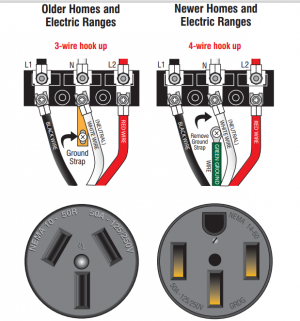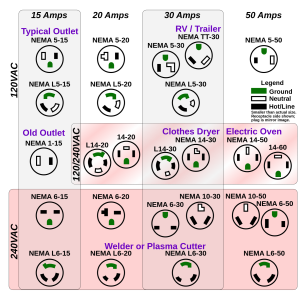-
Welcome back Guest! Did you know you can mentor other members here at H-M? If not, please check out our Relaunch of Hobby Machinist Mentoring Program!
You are using an out of date browser. It may not display this or other websites correctly.
You should upgrade or use an alternative browser.
You should upgrade or use an alternative browser.
Error proofing 220-volt
- Thread starter ltlvt
- Start date
- Joined
- Dec 18, 2022
- Messages
- 1,675
I had a discussion with someone on this forum a month or 3 ago about a very similar topic. Someone had asked about plugs and wire and My comment was that I found the plugs and receptacles which were rated/designated for the voltage/amps via standards for what I was doing. I was told it didn't matter because the regular plugs would work...... Flash forward, I understand Itivt's issue, he likely has a dual voltage cutter with a single 110v plug and no choice would be my guess, this sets us up for accidents. In the Garage I have 3 wire 220v 20A plugs for my Lathe and my Mill, I located the correct wall receptacles and the plugs which go with them, nothing else in the garage will plug into those and that is how I like it.Sorry, it is not clear how you plugged a 110V plug into a 22V receptacle? They both have different configurations to prevent that?
I worked at a skid shop many years ago and they had 2 little cracker boxes which were identical in appearance; but, one was a 110v and one was a 220/110v with a switch to select which you would be running off of. Both of these little welders had a 110v 30A plug and in on section of the shop they had a 220v plug for the 220/110v version to plug into. one find afternoon the 220/110v welder had been taken to a field job and someone needed to weld in that shop so they retrieved the 110v version plugged it in where they always plugged in the other welded and it caught on fire and burned up. My feelings are that if I have one of these machines I would install the correct wall receptacle for the volts/amps and make a small adapter cord for it so it requires a thoughtful moment when plugging in..... just my 2 cents worth.
I’m not following here? In the US a 220 line has 2 powers and a nuetral. A 110 outlet has one power and a neutral. Each receptacle and plug are sized accordingly. If using the proper plugs it’s 99% fool proof.
On a 110/220 welder, plasma cutter you are supplied with an adapter for the corresponding voltage wanted. Machine adjust accordingly. I don’t think any 110 outlet is rated for 30A. I’m just not seeing the confusion.
On a 110/220 welder, plasma cutter you are supplied with an adapter for the corresponding voltage wanted. Machine adjust accordingly. I don’t think any 110 outlet is rated for 30A. I’m just not seeing the confusion.
Dual voltage equipment usually comes with a plug for max amperage at the lowest possible voltage, and adapters to plug into the appropriate amperage/voltage receptacles for for other avalable voltages. Wiring the wrong voltage (or amperage) to a receptacle is just bad form. Nothing good comes of that.
- Joined
- Dec 18, 2022
- Messages
- 1,675
You have 220 volts that are setup with 2 hots and a neutral (3 pronged plug) and you have 220 volts that are wired with 2 hots, a neutral and a ground (4 pronged plug). See below:I’m not following here? In the US a 220 line has 2 powers and a nuetral. A 110 outlet has one power and a neutral. Each receptacle and plug are sized accordingly. If using the proper plugs it’s 99% fool proof.
On a 110/220 welder, plasma cutter you are supplied with an adapter for the corresponding voltage wanted. Machine adjust accordingly. I don’t think any 110 outlet is rated for 30A. I’m just not seeing the confusion.

Additionally, 110/120v 30Amp....

Guys if I have said it once I have said it many times, buy yourself an Ugly's, it'll save your butt....
- Joined
- Aug 29, 2019
- Messages
- 510
This is how and why I managed the Bozo. The only part I left out is a picture of the male plug on the plasma cutter and a short 6-foot cord I made up with the male female plugs on each end. This cord was plugged into 110volts from the wall and the other end had been powering the power feed on the mill. Getting in a hurry I to plug the lathe into the 220-volt cord I plugged it into the 22o volt receptacle before unplugging it from the power feed unit. And POP GOES THE POWER FEED. Really another good lesson for me. Using sloppy practices never pays off . It will and has come full circle to bite me in the butt. Hope the video explains it.
- Joined
- Aug 29, 2019
- Messages
- 510
I bought the Plasma cutter from a local welding supply company, and it did NOT come with the female plug or any kind of adapter. When I bought it I paid $1300 usd for it and it was the best one that could be had. Now you can buy the Chinese versions for less than $300. I'm sure someone sued the vendors of the latest ones for not having a dual voltage adapter so now they give everyone one.I’m not following here? In the US a 220 line has 2 powers and a nuetral. A 110 outlet has one power and a neutral. Each receptacle and plug are sized accordingly. If using the proper plugs it’s 99% fool proof.
On a 110/220 welder, plasma cutter you are supplied with an adapter for the corresponding voltage wanted. Machine adjust accordingly. I don’t think any 110 outlet is rated for 30A. I’m just not seeing the confusion.
- Joined
- Aug 29, 2019
- Messages
- 510
Correct. But what happens when you get a new toy? Answer: You want to play with it!Dual voltage equipment usually comes with a plug for max amperage at the lowest possible voltage, and adapters to plug into the appropriate amperage/voltage receptacles for for other avalable voltages. Wiring the wrong voltage (or amperage) to a receptacle is just bad form. Nothing good comes of that.

